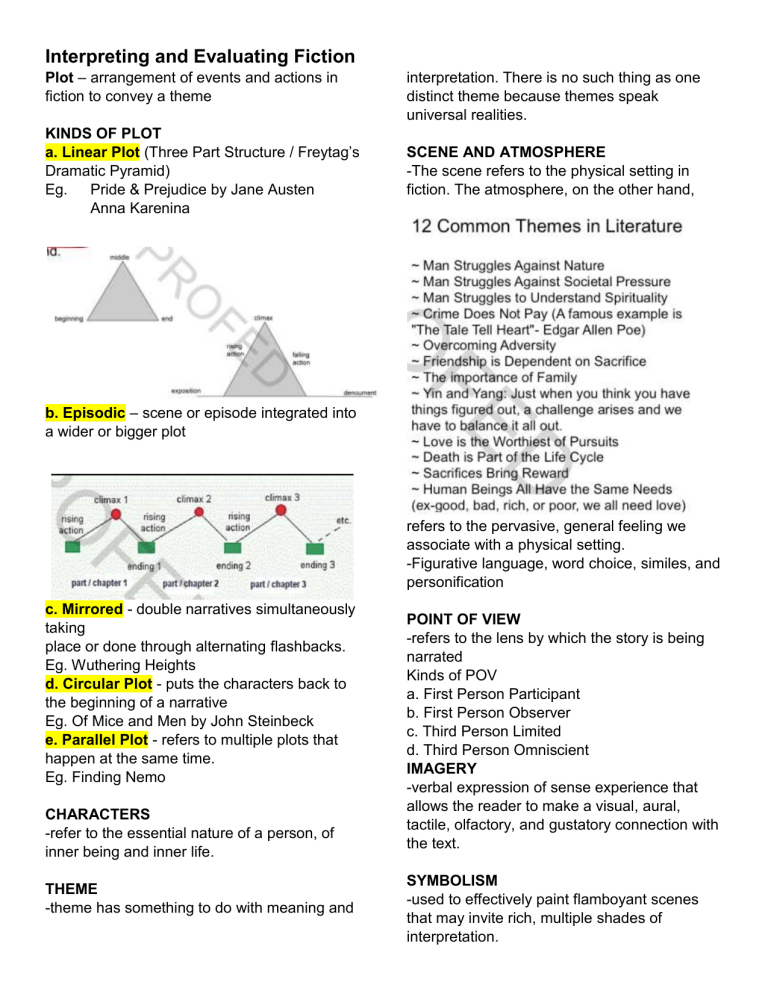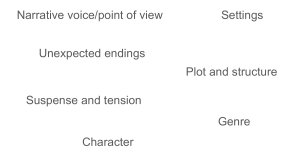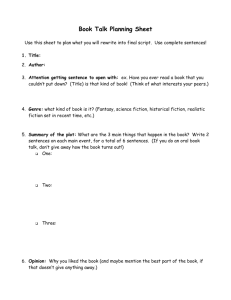
Interpreting and Evaluating Fiction Plot – arrangement of events and actions in fiction to convey a theme KINDS OF PLOT a. Linear Plot (Three Part Structure / Freytag’s Dramatic Pyramid) Eg. Pride & Prejudice by Jane Austen Anna Karenina interpretation. There is no such thing as one distinct theme because themes speak universal realities. SCENE AND ATMOSPHERE -The scene refers to the physical setting in fiction. The atmosphere, on the other hand, b. Episodic – scene or episode integrated into a wider or bigger plot refers to the pervasive, general feeling we associate with a physical setting. -Figurative language, word choice, similes, and personification c. Mirrored - double narratives simultaneously taking place or done through alternating flashbacks. Eg. Wuthering Heights d. Circular Plot - puts the characters back to the beginning of a narrative Eg. Of Mice and Men by John Steinbeck e. Parallel Plot - refers to multiple plots that happen at the same time. Eg. Finding Nemo CHARACTERS -refer to the essential nature of a person, of inner being and inner life. THEME -theme has something to do with meaning and POINT OF VIEW -refers to the lens by which the story is being narrated Kinds of POV a. First Person Participant b. First Person Observer c. Third Person Limited d. Third Person Omniscient IMAGERY -verbal expression of sense experience that allows the reader to make a visual, aural, tactile, olfactory, and gustatory connection with the text. SYMBOLISM -used to effectively paint flamboyant scenes that may invite rich, multiple shades of interpretation. STYLE & TONE Style is conditioned by point of view. This refers to the choice of language, voice, sentence types as well as structures that the writer uses. Tone refers to the writer’s attitude toward the subject and readers. FIGURATIVE LANGUAGE -The writer uses language to mean something other than its literal meaning, to produce a special effect or new meaning. TYPES OF FICTION 1. LITERARY 1Written by someone with serious artistic intentions who hope to broaden deepen, and sharpen the reader’s awareness of life 2. COMMERCIAL Written and published primarily to make money, and it makes money because it helps large numbers of people escape the tedium and stress of their lives MAINSTREAM FICTION • Used to describe both commercial and literary works that depict a daily reality familiar to most people. • Set in the 20th and present day 21st century. GENRE: MYSTERY • Focus: crime, usually murder. • Center on the attempts of wily detective type to solve the crime. • Subgenres: spy detective and crime stories. GENRE: ROMANCE • Aimed at diverting and entertaining women. • Easy to follow formula: - young inexperience girl living somewhat remote existence is courted or threatened by an evil man and then rescued by a valiant one. • Subgenres: historical, contemporary, fantasy romance, and romantic suspense. GENRE: WOMEN’S FICTION A category within the mainstream classified as ‘Women’s fiction’ Key characteristics: focus on relationships, one or more strong female protagonists, women triumphing over unbearable circumstances and the experiences of women. SUSPENSE/ THRILLER • Tense, exciting, often sensational works with ingenious plotting, swift action and continuous suspense. • Writer’s objective: to deliver a story with sustained tension, surprise, and constant sense of impending doom GENRE: WESTERN • Life on America’s post Civil War western frontier HORROR • Filled with gut-wrenching fear. • Roots: classic tales of Edgar Allan Poe • Present day: Mark Shelley, Clive Barker GENRE: YOUNG ADULT • 12 to 16 age range that speaks to the concerns of teenagers.





